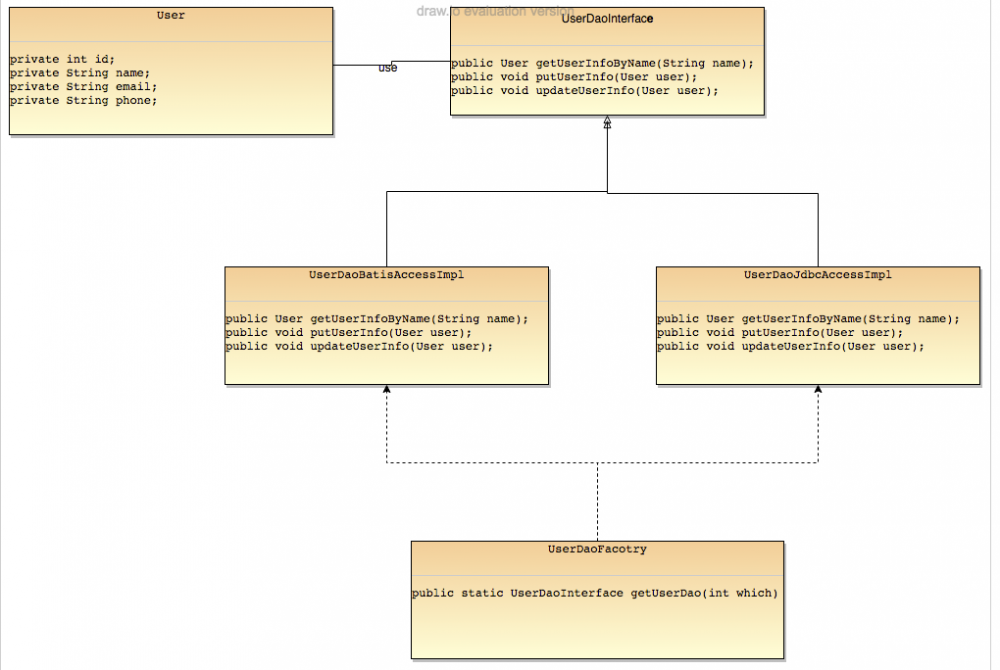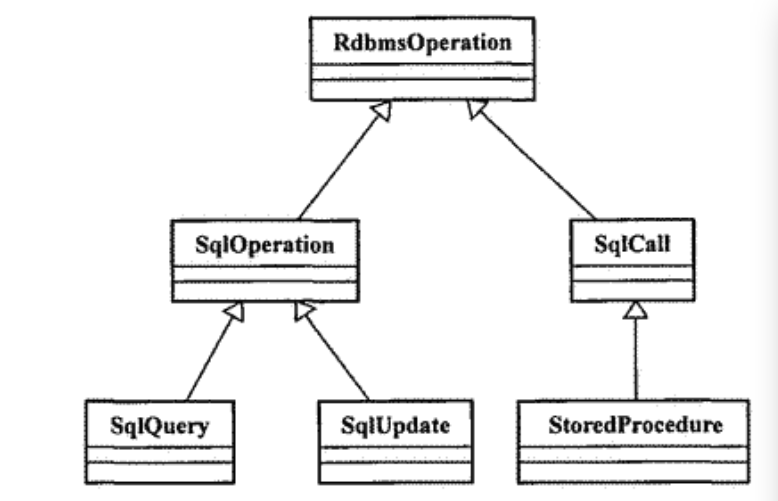spring-jdbc 的实现原理
前言
本篇文章将回答以下几个问题
- spring-jdbc 的出现是为了解决什么问题
- spring-jdbc 如何解决的这些问题
- 它的这种技术有何缺陷
首先希望你能带着这些问题来看这篇文章,也希望这篇文章能让你很好的解答这些问题。当然,这篇文章的终极目标是希望你能够借鉴spring-jdbc 的思想来解决我们在工作过程中所面临的问题。
如果你想了解,如何使用spring-jdbc,请绕道......
Dao 模式
为了实现数据和业务的分离,有人提出了Dao模式。Dao模式是数据处理的一种理想模式,(我认为)它带来了两个方面的好处:1、屏蔽数据访问的差异性;2、业务与数据分离。spring-jdbc 在本质上是一种Dao模式的具体实现。(Dao模式的详细介绍)
接下下我们用一个简单的例子(未具体实现)来简单介绍一下Dao模式(如下图所示)

从上面的UML图可以知道:
- 首先定义了一个User的操作接口UserDao,它定义了了获取用户信息、添加用户信息、更改用户信息的行为;
- 具体行为的由其实现类来实现,我们这里举了两个例子:Batis 实现和Jdbc实现(当然也可以缓存实现或file实现等),它实现具体获取或修改数据的行为;UserDaoFactory 生成具体的实现UserDao实现类(请参考下面代码)。
- 所以当我们在Service层(UserService)访问数据时,只 需要使用UserDaoFactory 生成一个具体的UserDao实现类就可以了,这样业务层就可以完全操作数据操作的具体实现( 参考下面UserService的具体实现)
public class User {
private int id;
private String name;
private String email;
private String phone;
public User() {
}
public int getId() {
return id;
}
public String getName() {
return name;
}
public String getEmail() {
return email;
}
public String getPhone() {
return phone;
}
public void setId(int id) {
this.id = id;
}
public void setName(String name) {
this.name = name;
}
public void setEmail(String email) {
this.email = email;
}
public void setPhone(String phone) {
this.phone = phone;
}
}
public interface UserDaoInterface {
public User getUserInfoByName(String name);
public void putUserInfo(User user);
public void updateUserInfo(User user);
}
public class UserDaoJdbcAccessImpl implements UserDaoInterface {
// Jdbc连接数据库等操作,未完成具体实现
private DataSource dataSource;
public User getUserInfoByName(String name) {
dataSource.getC
return new User();
}
public void putUserInfo(User user) {
}
public void updateUserInfo(User user) {
}
}
public class UserDaoBatisAccessImpl implements UserDaoInterface {
// Batis连接数据库等操作,未完成具体实现
public User getUserInfoByName(String name) {
return new User();
}
public void putUserInfo(User user) {
}
public void updateUserInfo(User user) {
}
}
public class UserDaoFacotry {
public static UserDaoInterface getUserDao(int which) {
switch(which) {
case 1:
return new UserDaoJdbcAccessImpl();
case 2:
return new UserDaoBatisAccessImpl();
default:
return null;
}
}
}
public class UserService {
public UserDaoInterface getUserDaoOperation() {
return UserDaoFacotry.getUserDao(1);
}
public void getUserInfo() {
User user = this.getUserDaoOperation().getUserInfoByName("xiaoming");
}
}
但在具体实现DaoImpl时遇到了一个问题,数据库的连接访问会抛出异常,且属于checked exception
public User getUserInfoByName(String name) {
try {
Connection connection = dataSource.getConnection();
User user = ....
return user;
} catch (SQLException e) {
} finally {
connection.close();
}
}
这是很尴尬的,因为此时我们不知道是要抛给上层业务还是catch之后进行处理。catch之后进行处理,由于屏蔽异常会让客户端难以排查问题,如果直接抛出去也带来更严重的问题(必须更改接口且不同数据库所抛出的异常不一样),如下所示
public User getUserInfoByName(String name) throw SQLException, NamingException ... {
try {
Connection connection = dataSource.getConnection();
User user = ....
return user;
} finally {
connection.close();
}
}
jdbc 为了解决不同数据库带来的异常差异化,则对异常进行统一转换,并抛出unchecked异常。具体抛出的异常可以在org.springframework.dao中查看

这是很尴尬的,因为此时我们不知道是要抛给上层业务还是catch之后进行处理。catch之后进行处理,由于屏蔽异常会让客户端难以排查问题,如果直接抛出去也带来更严重的问题(必须更改接口且不同数据库所抛出的异常不一样),如下所示
具体异常所代表的含义:
Spring的DAO异常层次
| 异常 | 何时抛出 |
|---|---|
| CleanupFailureDataAccessException | 一项操作成功地执行,但在释放数据库资源时发生异常(例如,关闭一个Connection |
| DataAccessResourceFailureException | 数据访问资源彻底失败,例如不能连接数据库 |
| iMac | 10000 元 |
| DataIntegrityViolationException | Insert或Update数据时违反了完整性,例如违反了惟一性限制 |
| DataRetrievalFailureException | 某些数据不能被检测到,例如不能通过关键字找到一条记录 |
| DeadlockLoserDataAccessException | 当前的操作因为死锁而失败 |
| IncorrectUpdateSemanticsDataAccessException | Update时发生某些没有预料到的情况,例如更改超过预期的记录数。当这个异常被抛出时,执行着的事务不会被回滚 |
| InvalidDataAccessApiusageException 一个数据访问的JAVA | API没有正确使用,例如必须在执行前编译好的查询编译失败了 |
| invalidDataAccessResourceUsageException | 错误使用数据访问资源,例如用错误的SQL语法访问关系型数据库 |
| OptimisticLockingFailureException | 乐观锁的失败。这将由ORM工具或用户的DAO实现抛出 |
| TypemismatchDataAccessException | Java类型和数据类型不匹配,例如试图把String类型插入到数据库的数值型字段中 |
| UncategorizedDataAccessException | 有错误发生,但无法归类到某一更为具体的异常中 |
spring-jdbc
我们可以将spring-jdbc 看作Dao 模式的一个最佳实践,它只是使用了template模式,实现了最大化的封装,以减少用户使用的复杂性。spring-jdbc 提供了两种模式的封装,一种是Template,一种是操作对象的模式。操作对象的模式只是提供了面向对象的视觉(template 更像面向过程),其底层的实现仍然是采用Template。
接下来我们将会了解Template 的封装过程。
2.1 Template
还是延用上述例子,如果这里我们需要根据用户名查询用户的完整信息,将采用下面的方式实现查询
public class UserDaoJdbcAccessImpl implements UserDaoInterface {
// Jdbc连接数据库等操作,未完成具体实现
private DataSource dataSource;
public User getUserInfoByName(String name) {
String sql = "....." + name;
Connection connection = null;
try {
connection = DataSourceUtils.getConnection(dataSource);
Statement statement = connection.createStatement();
ResultSet resultSet = statement.executeQuery(sql);
List<User> userList = Lists.newArrayList();
while(resultSet.next()) {
User user = new User();
user.setId(resultSet.getInt(1));
user.setName(name);
user.setEmail(resultSet.getString(3));
user.setPhone(resultSet.getString(4));
userList.add(user);
}
connection.close();
connection = null;
statement.close();
return userList;
} catch (Exception e) {
throw new DaoException(e);
} finally {
if (connection != null) {
try {
connection.close();
} catch (SQLException e) {
log.error(".....");
}
}
}
}
当我们只需要完成一个操作的项目时,这种方式还可以接受,但当项目中有大量的DAO需要操作时,难免过程中会出现各种问题,如忘记关闭连接等。
其实我们可以发现整个的数据库的操作实现可以分为四个部分:资源管理(数据库的连接关闭等操作)、sql执行(查询、更新等)、结果集的处理(将sql查询结果转化)、异常处理。
那是不是可以将公共部分抽象成一个模板进行使用呢?现在我们来定义一个Jdbc的一个模板
public class JdbcTemplate {
public final Object execute(StatementCallback callback) {
Connection connection = null;
Statement statement = null;
try {
connection = getConnetion();
statement = con.createStatement();
Object ret = callback.doWithStatement(callback);
return retValue;
} catch (SQLException e) {
DateAccessException ex = translateSqlException(e);
throw ex;
} finally {
closeStatement(statement);
releaseConnection(connection);
}
}
}
Template 定义了关注了操作的所有过程,只需要传递一个callback,就可以帮我们处理各种细节化操作,这些细节化操作包括:获取数据库连接;执行操作;处理异常;资源释放。那我们在使用时就可以简化为
private JdbcTemplate jdbcTemplate;
// Jdbc连接数据库等操作,未完成具体实现
private DataSource dataSource;
public User getUserInfoByName(String name) {
StatementCallback statementCallback = new StatementCallback() {
@Override
public Object doInStatement(Statement stmt) throws SQLException, DataAccessException {
return null;
}
}
return jdbcTemplate.execute(statementCallback);
}
实际上,Template 在封装时远比这个复杂,接下来我们就看一下spring-jdbc 是如何对jdbc进行封装的

JdbcTemplate 实现了JdbcOperations接口和继承了JdbcAccessor。
JdbcOperations 定义了数据库的操作,excute、 query、update 等,它是对行为的一种封装。
JdbcAccessor 封装了对资源的操作以及异常的处理,可以看一下源码,比较短。
public abstract class JdbcAccessor implements InitializingBean {
/** Logger available to subclasses */
protected final Log logger = LogFactory.getLog(getClass());
private DataSource dataSource;
private SQLExceptionTranslator exceptionTranslator;
private boolean lazyInit = true;
/**
* Set the JDBC DataSource to obtain connections from.
*/
public void setDataSource(DataSource dataSource) {
this.dataSource = dataSource;
}
/**
* Return the DataSource used by this template.
*/
public DataSource getDataSource() {
return this.dataSource;
}
/**
* Specify the database product name for the DataSource that this accessor uses.
* This allows to initialize a SQLErrorCodeSQLExceptionTranslator without
* obtaining a Connection from the DataSource to get the metadata.
* @param dbName the database product name that identifies the error codes entry
* @see SQLErrorCodeSQLExceptionTranslator#setDatabaseProductName
* @see java.sql.DatabaseMetaData#getDatabaseProductName()
*/
public void setDatabaseProductName(String dbName) {
this.exceptionTranslator = new SQLErrorCodeSQLExceptionTranslator(dbName);
}
/**
* Set the exception translator for this instance.
* <p>If no custom translator is provided, a default
* {@link SQLErrorCodeSQLExceptionTranslator} is used
* which examines the SQLException's vendor-specific error code.
* @see org.springframework.jdbc.support.SQLErrorCodeSQLExceptionTranslator
* @see org.springframework.jdbc.support.SQLStateSQLExceptionTranslator
*/
public void setExceptionTranslator(SQLExceptionTranslator exceptionTranslator) {
this.exceptionTranslator = exceptionTranslator;
}
/**
* Return the exception translator for this instance.
* <p>Creates a default {@link SQLErrorCodeSQLExceptionTranslator}
* for the specified DataSource if none set, or a
* {@link SQLStateSQLExceptionTranslator} in case of no DataSource.
* @see #getDataSource()
*/
public synchronized SQLExceptionTranslator getExceptionTranslator() {
if (this.exceptionTranslator == null) {
DataSource dataSource = getDataSource();
if (dataSource != null) {
this.exceptionTranslator = new SQLErrorCodeSQLExceptionTranslator(dataSource);
}
else {
this.exceptionTranslator = new SQLStateSQLExceptionTranslator();
}
}
return this.exceptionTranslator;
}
/**
* Set whether to lazily initialize the SQLExceptionTranslator for this accessor,
* on first encounter of a SQLException. Default is "true"; can be switched to
* "false" for initialization on startup.
* <p>Early initialization just applies if {@code afterPropertiesSet()} is called.
* @see #getExceptionTranslator()
* @see #afterPropertiesSet()
*/
public void setLazyInit(boolean lazyInit) {
this.lazyInit = lazyInit;
}
/**
* Return whether to lazily initialize the SQLExceptionTranslator for this accessor.
* @see #getExceptionTranslator()
*/
public boolean isLazyInit() {
return this.lazyInit;
}
/**
* Eagerly initialize the exception translator, if demanded,
* creating a default one for the specified DataSource if none set.
*/
@Override
public void afterPropertiesSet() {
if (getDataSource() == null) {
throw new IllegalArgumentException("Property 'dataSource' is required");
}
if (!isLazyInit()) {
getExceptionTranslator();
}
}
}
源码有三个参数:datasource、exceptionTranslator(转换各种数据库方案商的不同的数据库异常)、lazyInit(延时加载:是否在applicationContext 初始化时就进行实例化)
在使用的过程中我们可以看到,只需要提供一个statementCallback,就可以实现对Dao 的各种操作。spring-jdbc 为了满足各种场景的需要,为我们提供了四组不同权限的callback
在使用的过程中我们可以看到,只需要提供一个statementCallback,就可以实现对Dao 的各种操作。spring-jdbc 为了满足各种场景的需要,为我们提供了四组不同权限的callback
| callback | 说明 |
|---|---|
| CallableStatementCallback | 面向存储过程 |
| ConnectionCallback | 面向连接的call,权限最大(但一般情况应该避免使用,造成操作不当) |
| PreparedStatementCallback | 包含查询询参数的的callback,可以防止sql 注入 |
| StatementCallback | 缩小了ConnectionCallback的权限范围,不允许操作数据库的连接 |
我们再看一下JdbcTemplate 的封装
public <T> T execute(ConnectionCallback<T> action) throws DataAccessException {
Assert.notNull(action, "Callback object must not be null");
Connection con = DataSourceUtils.getConnection(getDataSource());
try {
Connection conToUse = con;
if (this.nativeJdbcExtractor != null) {
// Extract native JDBC Connection, castable to OracleConnection or the like.
conToUse = this.nativeJdbcExtractor.getNativeConnection(con);
}
else {
// Create close-suppressing Connection proxy, also preparing returned Statements.
conToUse = createConnectionProxy(con);
}
return action.doInConnection(conToUse);
}
catch (SQLException ex) {
// Release Connection early, to avoid potential connection pool deadlock
// in the case when the exception translator hasn't been initialized yet.
DataSourceUtils.releaseConnection(con, getDataSource());
con = null;
throw getExceptionTranslator().translate("ConnectionCallback", getSql(action), ex);
}
finally {
DataSourceUtils.releaseConnection(con, getDataSource());
}
}
有两个需要注意的地方
Connection con = DataSourceUtils.getConnection(getDataSource());
这里创建连接使用的是DataSourceUtils,而不是datasource.getConnection,这是由于考虑到了事务处理的因素。
if (this.nativeJdbcExtractor != null) {
// Extract native JDBC Connection, castable to OracleConnection or the like.
conToUse = this.nativeJdbcExtractor.getNativeConnection(con);
}
这里并不一定使用的是jdbc的connection,因为jdbc是一种统一化封装,而忽略了各个sql供应商的差异性。有时间我们需要使用某一数据库的某种特性(比如Oracle sql)时,就可以通过对nativeJdbcExtractor来达到目的。
JdbcTemplate 还有几个演生的template,这里都不再详细介绍。
Ok,关于template 的介绍就到此为止(这里更倾向于介绍各种技术的实现原理,而非如何使用)。
2.2 对象模式
对象模式其实只是把Template 中的操作封装成各个对象,而其本质的实现方式仍然是Template

三、缺陷
spring-jdbc的封装方式得到了广泛认可,但并不代表它是一个友好的的操作数据库的工具。 从上面的介绍过程中,我们可以感受到jdbc 的封装是面向底层的,所以它对于上层的使用方并不那么友好。jdbc 并未能真正的实现业务和数据的完全分离,对callback的定义仍然会穿插在业务当中,所以在实际的业务应用中,已经很少直接使用jdbc。因此spring 也对很多其它的ORM框架进行了支持,如ibatis,hibernate,JDO等等,这些更高级对用户更加友好。接下我会用一系列文章,对这些框架进行介绍
四、总结
我们再来回顾一下最前面提出的三个问题:
- spring-jdbc 是为了解决数据和业务分离的问题,使客户端能够更专注于业务层面,而不必关注数据库资源的连接释放及异常处理等逻辑。
- spring-jdbc 采用dao模式实现了业务和数据的分离;使用模板模式,实现了逻辑的封装
- spring-jdbc 属于面向低层的实现,对用户不太友好。
个人能力有限,有错误之处还请指证.....
- 本文标签: db cat 时间 锁 ACE SQL执行 tab 数据库 代码 缩小 http ORM 源码 Oracle API 参数 src 业务层 本质 编译 tar 管理 list Connection bean 专注 update IDE value dataSource Service id java https 数据 实例 Java类 Action 希望 spring UI App 总结 Property iBATIS mail sql CTO final 文章 IO
- 版权声明: 本文为互联网转载文章,出处已在文章中说明(部分除外)。如果侵权,请联系本站长删除,谢谢。
- 本文海报: 生成海报一 生成海报二











![[HBLOG]公众号](https://www.liuhaihua.cn/img/qrcode_gzh.jpg)

